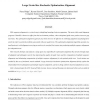54 search results - page 6 / 11 » FastPCMSA: An Improved Parallel Algorithm for the Constraine... |
CF
2009
ACM
14 years 2 months ago
2009
ACM
The exponential growth of databases that contains biological information (such as protein and DNA data) demands great efforts to improve the performance of computational platforms...
BIBE
2006
IEEE
14 years 1 months ago
2006
IEEE
DNA sequence alignment is a critical step in identifying homology between organisms. The most widely used alignment program, ClustalW, is known to suffer from the local minima pro...
BMCBI
2010
13 years 7 months ago
2010
Background: Determining beforehand specific positions to align (anchor points) has proved valuable for the accuracy of automated multiple sequence alignment (MSA) software. This f...
BIB
2008
13 years 7 months ago
2008
The accuracy and scalability of multiple sequence alignment (MSA) of DNAs and proteins have long been and are still important issues in bioinformatics. To rapidly construct a reas...
WABI
2005
Springer
14 years 1 months ago
2005
Springer
In contrast to proteins, many classes of functionally related RNA molecules show a rather weak sequence conservation but instead a fairly well conserved secondary structure. Hence ...

